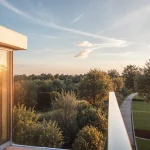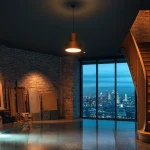Understanding the Unique Challenges of Terraced Homes
In the UK architecture landscape, terraced homes hold a special place due to their historical and cultural significance. Originating in the 18th century, these homes were ingeniously designed to maximise space in densely populated areas. However, the small living spaces inherent in terraced homes present unique challenges. The narrow, elongated floor plans can make it difficult to create roomy, functional interiors.
Space limitations are a common issue, as terraced homes typically feature compact rooms and restricted layouts. These architectural constraints necessitate clever solutions to optimise every square inch. Historical elements like bay windows or cosy fireplaces add character but can further complicate the efficient use of space.
Also to see : Creating a Beautiful Low-Maintenance Coastal Garden in the UK: Expert Tips for Effortless Upkeep
The importance of maximising efficiency in such small footprints cannot be overstated. Residents often seek innovative ways to enhance practicality without sacrificing comfort. By addressing these design considerations, homeowners can transform compact living areas into more functional and aesthetically pleasing environments.
Understanding and responding to the challenges of terraced homes is essential for anyone looking to live comfortably within these iconic structures. Through creative design and a focus on efficiency, it’s possible to embrace and celebrate the features of terraced dwellings while overcoming their inherent limitations.
Have you seen this : Creating a Flood-Proof Garden: Essential Strategies for UK Homeowners in Vulnerable Zones
Innovative Design Solutions for Space Optimization
The challenge of optimising space in terraced homes is a common concern, particularly with the increasing demand for clever space-saving designs. One effective approach is employing multifunctional furniture. These pieces serve dual purposes, such as a bed that folds into the wall or a dining table that doubles as an office desk. Choosing the right multifunctional furniture can significantly enhance the utility of small areas without crowding them.
An open plan living space is another innovative interior design strategy to consider. By removing unnecessary walls, homeowners can create a sense of spaciousness and improve light flow. Open layouts encourage a seamless transition between living spaces, though it’s important to maintain privacy with strategic use of furniture placement and rugs.
Utilising vertical space also offers substantial benefits. Vertical shelving and tall bookcases or hanging storage can transform wasted wall space into efficient storage solutions, freeing up floor space. Emphasising verticality not only maximises storage but can also draw the eye upwards, creating a perception of a larger room.
Incorporating these innovative layouts can transform the compact living environment of terraced homes into a more functional and inviting space.
Practical Tips for Layout and Arrangement
When it comes to creating a functional interior layout in terraced homes, clever arrangement is essential. Begin by evaluating how furniture placement affects both the flow and accessibility of a space. Arranging pieces to encourage natural traffic paths can make compact areas feel larger and more navigable.
Techniques for maximizing natural light are crucial, especially in smaller, enclosed spaces. Consider the strategic use of mirrors and light colours to reflect light and enhance brightness, creating an airy atmosphere. Positioning larger furniture items such as sofas and tables near windows can help emphasize and make better use of available views, connecting indoor and outdoor environments.
Zoning different areas within an open layout helps designate spaces for various activities, such as dining, relaxing, or working. This can be achieved through thoughtful placement of rugs, varying wall colours, or using furniture as subtle dividers.
Adopting these strategies can significantly improve the functionality and comfort of small living spaces, allowing homeowners to enjoy both practicality and elegance in their terraced homes.
Storage Solutions for Every Nook and Cranny
Efficient storage solutions are essential for maximising the utility of terraced homes. Every bit of space counts, and creative organisation can make a significant impact. The concept of built-in storage options involves integrating storage seamlessly into the existing architecture. Custom built-in shelving and cabinetry can transform dead space into valuable storage areas. These designs should consider the home’s unique structure and layout, offering both aesthetic appeal and functionality.
Creative use of underutilized areas is another key strategy for optimising storage. Identifying spaces that often go overlooked, such as corners and areas beneath stairs, provides opportunities to add storage without intruding on living space. There’s a wealth of innovative ideas for using these spaces, from compact bookcases to hidden drawers. Successful transformations frequently demonstrate how small tweaks can lead to big improvements.
These approaches not only enhance organisation but also contribute to efficient space management within terraced homes. By adopting these solutions, homeowners can create more liveable environments that accommodate both their belongings and lifestyle needs, all while maintaining the home’s charm and character.
Navigating UK Regulations and Trends
Navigating UK regulations is crucial for addressing renovation and design aspirations in terraced homes. Building and remodelling in the UK requires adherence to strict regulatory requirements, such as planning permissions and building codes. These regulations ensure safety and maintain the architectural integrity of historic structures. For instance, properties in conservation areas may face restrictions on external modifications, necessitating thoughtful planning.
Current architecture trends in the UK, like sustainability and the use of eco-friendly materials, increasingly influence terraced home designs. Incorporating energy-efficient solutions and sustainable materials aligns with both modern sensibilities and regulatory standards.
To successfully integrate design ideas within the framework of UK regulations, homeowners should engage with professionals familiar with local laws and trends. This ensures compliance while also capturing the essence of contemporary design.
Staying informed and proactive in understanding these parameters helps blend traditional charm with modern aesthetics and functionality. This approach allows homeowners to undertake home redesign projects that respect historical significance while embracing innovative and practical design solutions.
Case Studies and Visual Inspiration
Visual inspiration through real-life design case studies offers valuable insights into transforming terraced homes. Homeowners often look for successful projects to guide their own renovations. By examining before-and-after transformations, we can understand the impact of thoughtful design choices on both aesthetics and functionality. These transformations reveal how strategic adaptations, such as integrating space-saving designs and enhancing natural light, can dramatically improve small living spaces.
Feedback from residents who have undergone such changes often highlights their satisfaction with the improved flow, increased storage, and better light management. Sharing these experiences provides practical advice for others contemplating similar projects.
Leading UK architects continue to push boundaries, creating innovative projects that address the unique challenges of terraced homes. By delving into the goals and solutions of these designs, one can gain an understanding of how to balance modern requirements with historical charm.
These inspiring examples not only offer practical solutions but also encourage homeowners to explore new possibilities. By learning from successful projects, individuals can confidently embark on their own home improvements, ensuring both comfort and style in their terraced dwellings.










